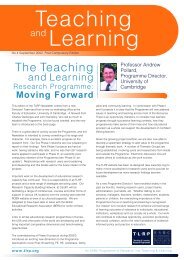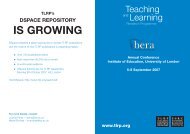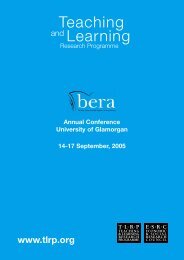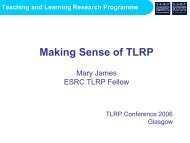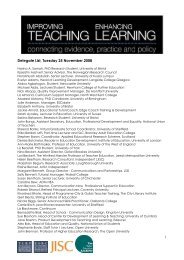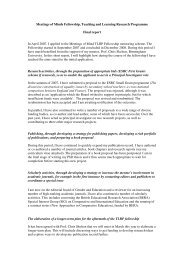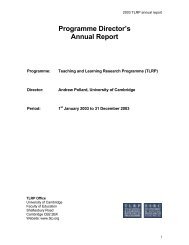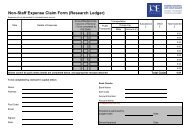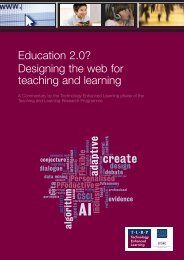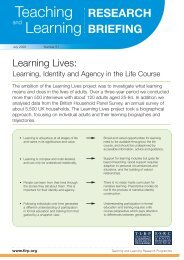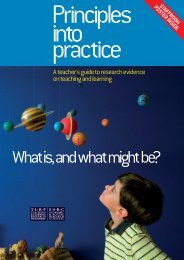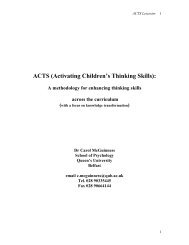Teachers - Teaching and Learning Research Programme
Teachers - Teaching and Learning Research Programme
Teachers - Teaching and Learning Research Programme
Create successful ePaper yourself
Turn your PDF publications into a flip-book with our unique Google optimized e-Paper software.
15<br />
While not disagreeing with the kinds of analysis offered by the likes of McLauglin <strong>and</strong><br />
Fullan (1994; 1999), it is a characteristic of this approach that it seeks to create<br />
‘professional communities of practice’ based on the belief that in the right conditions all<br />
teachers will participate in reform. This view has been challenged by Goodson (2000)<br />
who, in the face of similar evidence as that provided by Woods et al (1997) argues many<br />
teachers now sustain their creativity by engaging in activities unrelated to teaching or<br />
education. Although Fullan (1999: 4-6) argues that change is both complex <strong>and</strong><br />
evolutionary, neither he nor Mclaughlin have much to say about the processes by which<br />
individual teachers move from mere awareness of reform to a point where they are<br />
willing to forgo additional resources <strong>and</strong> work without the active support of colleagues in<br />
their own school. In our work on clustering in small rural schools (Galton <strong>and</strong><br />
Hargreaves 1995) where some teachers, including headteachers, were reluctant to<br />
collaborate for fear of losing autonomy in matters of resourcing <strong>and</strong> staffing, committed<br />
teachers in the cluster initially formed the ‘community of practice’. Other teachers,<br />
st<strong>and</strong>ing on the periphery of the reform, made decisions on the basis of their own selfinterests.<br />
They viewed after school cluster planning meetings as a drain of their valuable<br />
time <strong>and</strong> refused to attend. The bulk of teachers, in accepting there might be benefits in<br />
clustering chose to concentrate on the practical problems of working together on common<br />
curriculum tasks without being over-concerned with the consequences for pupil learning.<br />
Only the committed teachers viewed the reform as an opportunity to promote pupils’<br />
cognitive development. As Fullan (1999:47) observes, ‘the intellectual burgeoning of the<br />
quality <strong>and</strong> depth of pedagogical knowledge <strong>and</strong> means of enhancing learning for all has<br />
barely touched schools’. Moving teachers along the continuum that begins with ‘thinking<br />
about self’ <strong>and</strong> moves through ‘thinking about tasks’ to ‘thinking about the child’ (Fuller<br />
<strong>and</strong> Brown 1975) appears to be central to the creation of communities of practice capable<br />
of sustaining change. As yet we know little of this developmental process.<br />
Finally, I want to look at three projects which are part of the TLRP to explore how far<br />
they incorporate the criteria set out by McLaughlin. A summary is presented in Table 2.<br />
The first of these projects is the one in which I am involved with Peter Blatchford <strong>and</strong><br />
Peter Kutnick. It is called the SPRING (Social Pedagogy <strong>Research</strong> into Grouping)<br />
Project <strong>and</strong> seeks to explore ways of making classroom groups more effective to enhance



